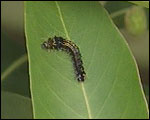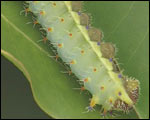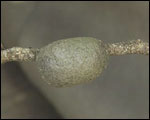Plant
Doctor Archive

Caterpillars
on my plants
 I
have caterpillars on my eucalyptus tree. How can I get rid of them? I
have caterpillars on my eucalyptus tree. How can I get rid of them?
 These
are the caterpillars of the gum emperor moth (see photo above —
middle). You usually find them, as the name suggests, on eucalyptus
species, but sometimes they'll go for liquidambar or even silver
birch. They came from Australia almost 100 years ago, and they're
here to stay. These
are the caterpillars of the gum emperor moth (see photo above —
middle). You usually find them, as the name suggests, on eucalyptus
species, but sometimes they'll go for liquidambar or even silver
birch. They came from Australia almost 100 years ago, and they're
here to stay.
Here's the problem. When
a little eucalyptus gets hammered by these beautiful caterpillars,
they will have some detrimental effects, basically because all the
green material has been removed.
 Before
we do anything about control, we need to take a look at the life
cycle of the insect. Before
we do anything about control, we need to take a look at the life
cycle of the insect.
It all starts with some
sizeable eggs laid on the leaves (see photo above — far right)
by the female. These hatch into small black hairy caterpillars.
They don't eat much at this stage, but the caterpillars change their
skins in order to grow, and the bigger they get, the more they eat.
 Of
course, caterpillars are the feeding-and-growing stage of the insect's
life cycle. They can double their weight every 48 hours. When they're
getting really sizeable, that's when a lot of foliage is removed,
and the caterpillar starts to produce sizeable droppings, which
can be as big as raisins, but I wouldn't try eating them. Of
course, caterpillars are the feeding-and-growing stage of the insect's
life cycle. They can double their weight every 48 hours. When they're
getting really sizeable, that's when a lot of foliage is removed,
and the caterpillar starts to produce sizeable droppings, which
can be as big as raisins, but I wouldn't try eating them.
When the caterpillars
are fully grown they spin themselves a nice silken cocoon, in which
they change into a pupa. After a month of metamorphosis, the pupa
hatches and the moth makes a hole in it and emerges.
 The
adult moths are a beautiful fawn-brown with pink wing tips and conspicuous
eye spots. These adults then start the whole life cycle all over
again. The
adult moths are a beautiful fawn-brown with pink wing tips and conspicuous
eye spots. These adults then start the whole life cycle all over
again.
So, what can you do to
control these caterpillars on your eucalyptus?
If you're fearing for
the safety of a small tree, use any insecticides you like —
Carbyral, Maldison. Caterpillars are susceptible to that.
If you go organic, you
can use pyrethrum or Dipel, which contains BTK and gives those caterpillars
a pretty lethal gut disease.
But hang on a minute,
I've got a better idea. Why not pick off the easy-to-spot caterpillars
and take them to a school for their nature table? They make beautiful
life-cycle studies.
Ruud Kleinpaste
 Advice
by Dr Dan Blanchon from Unitec's Diploma in Sustainable Horticulture and Bachelor
of Resource Management. Advice
by Dr Dan Blanchon from Unitec's Diploma in Sustainable Horticulture and Bachelor
of Resource Management.
Reproduced
with permission from NZOOM Home and Garden content,
from the previous
website of 
The views expressed here are not necessarily those of the RNZIH
 |
|
HOME
AND GARDEN
|
|
|
|